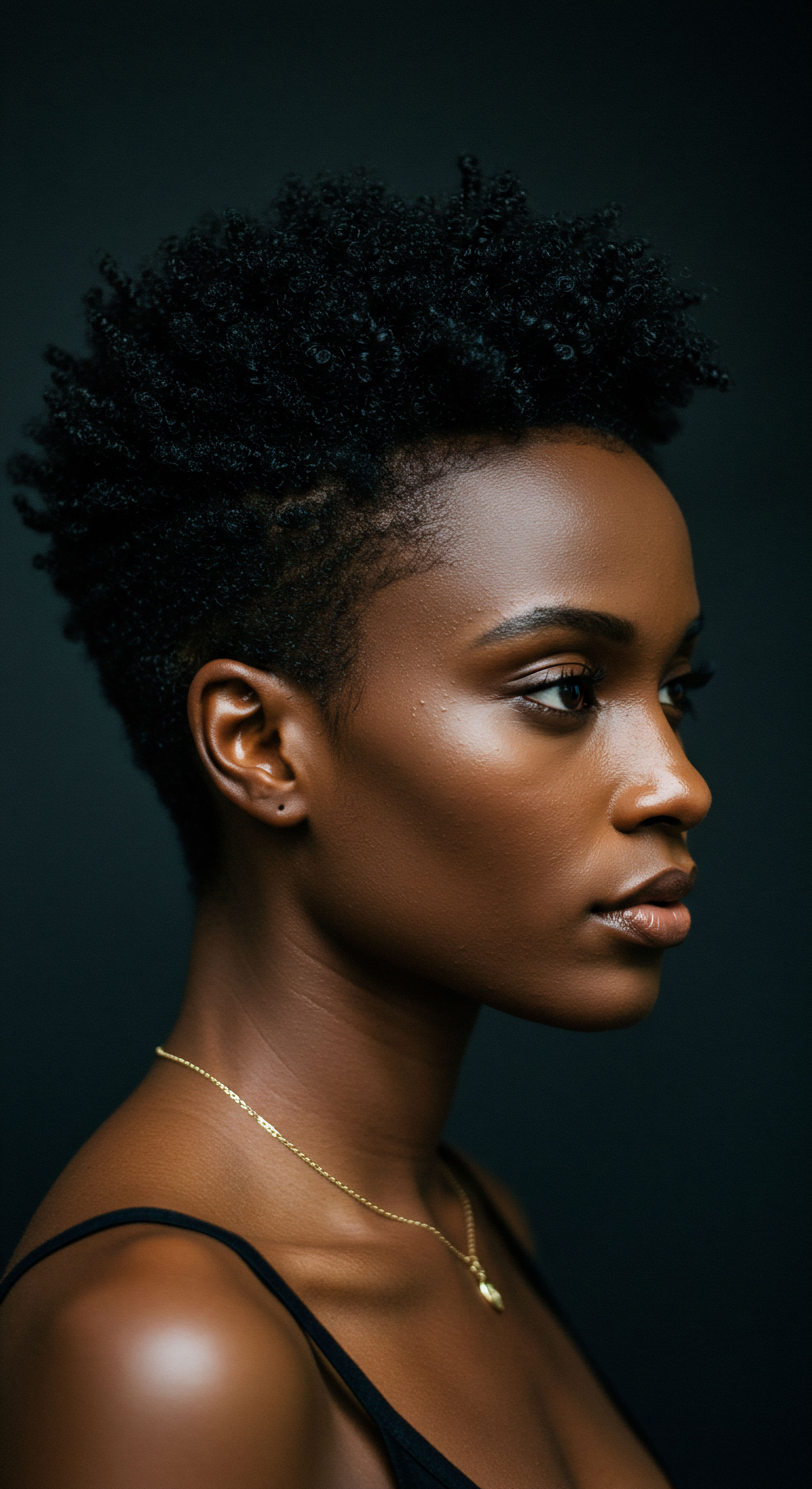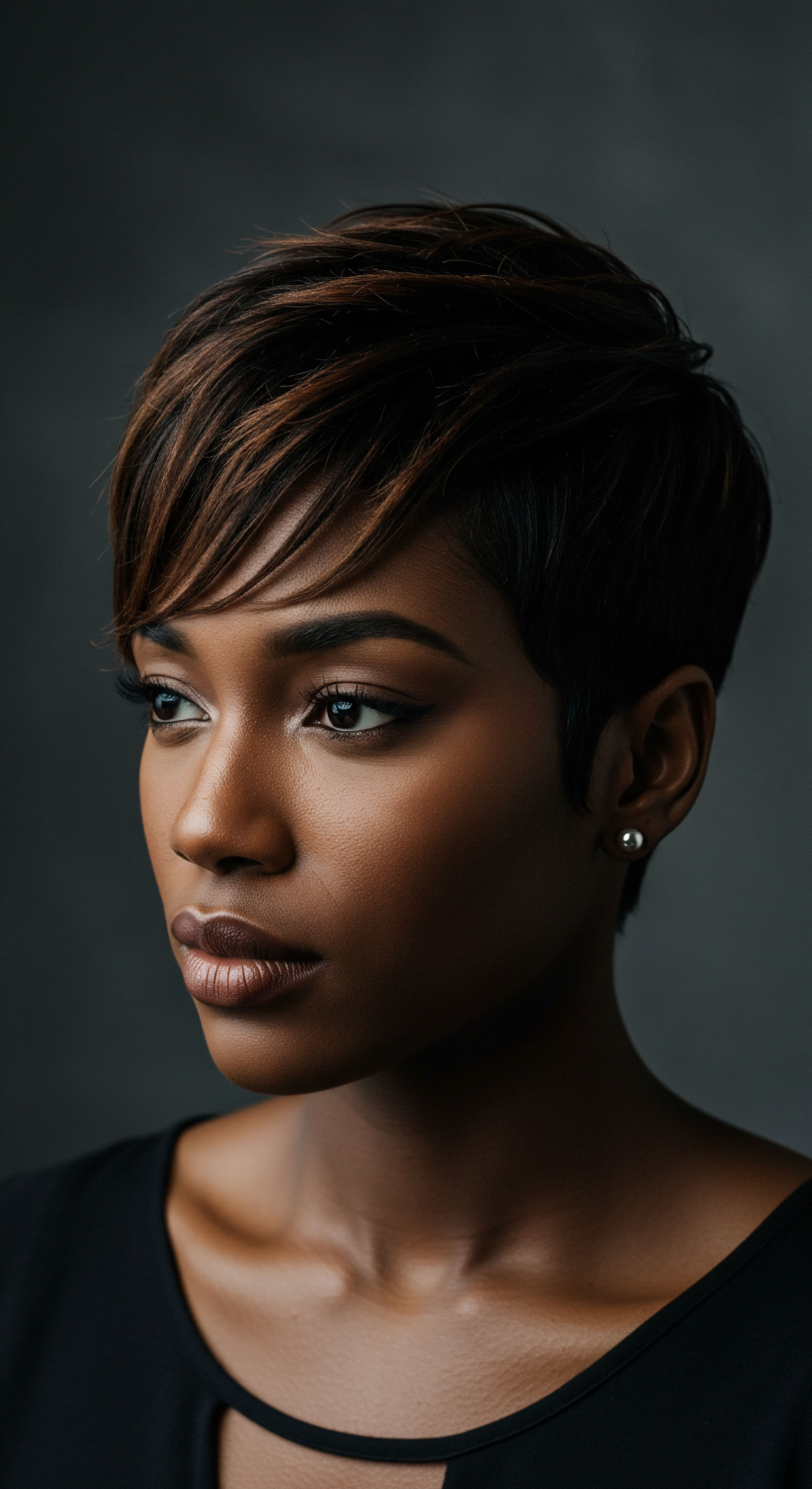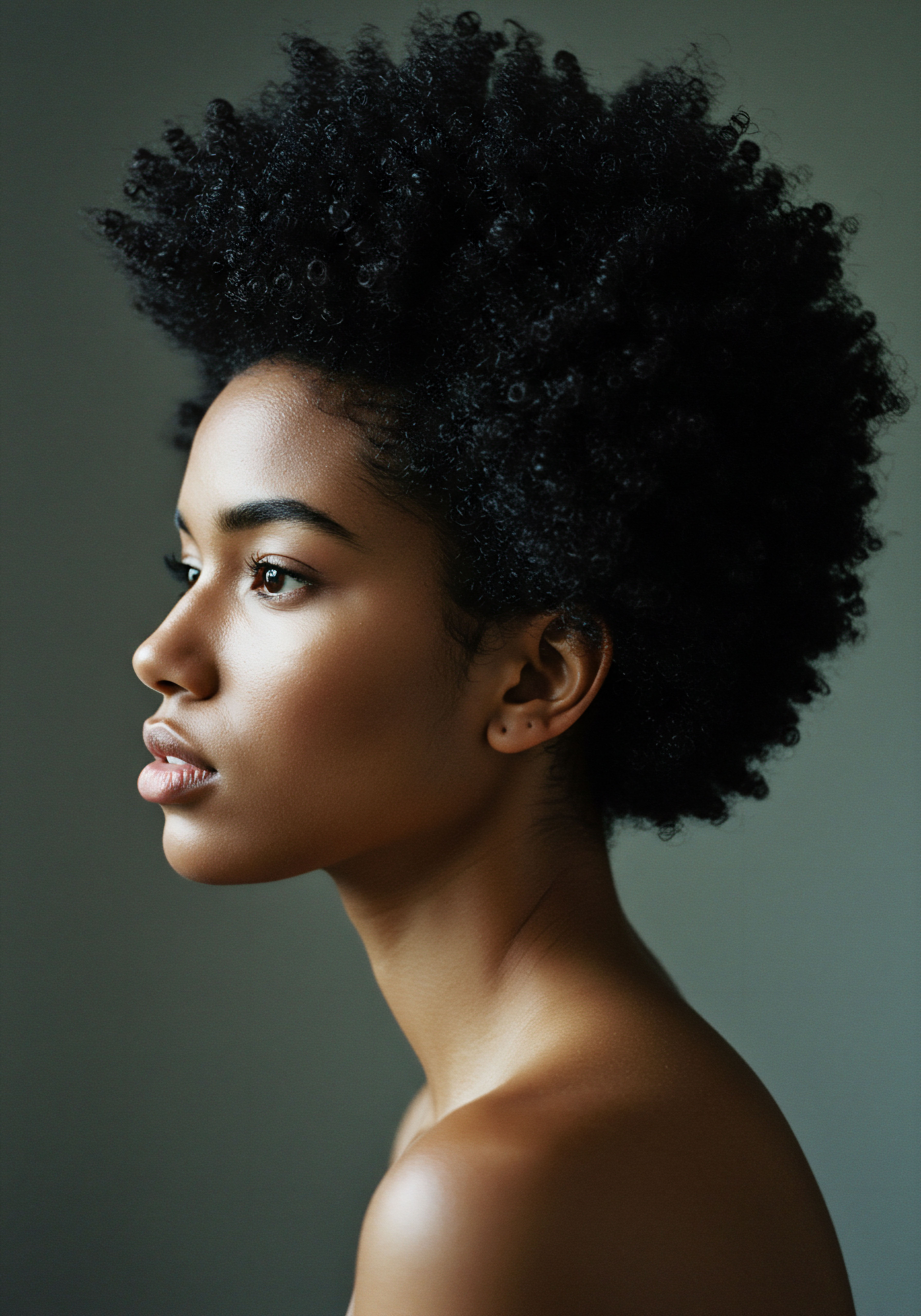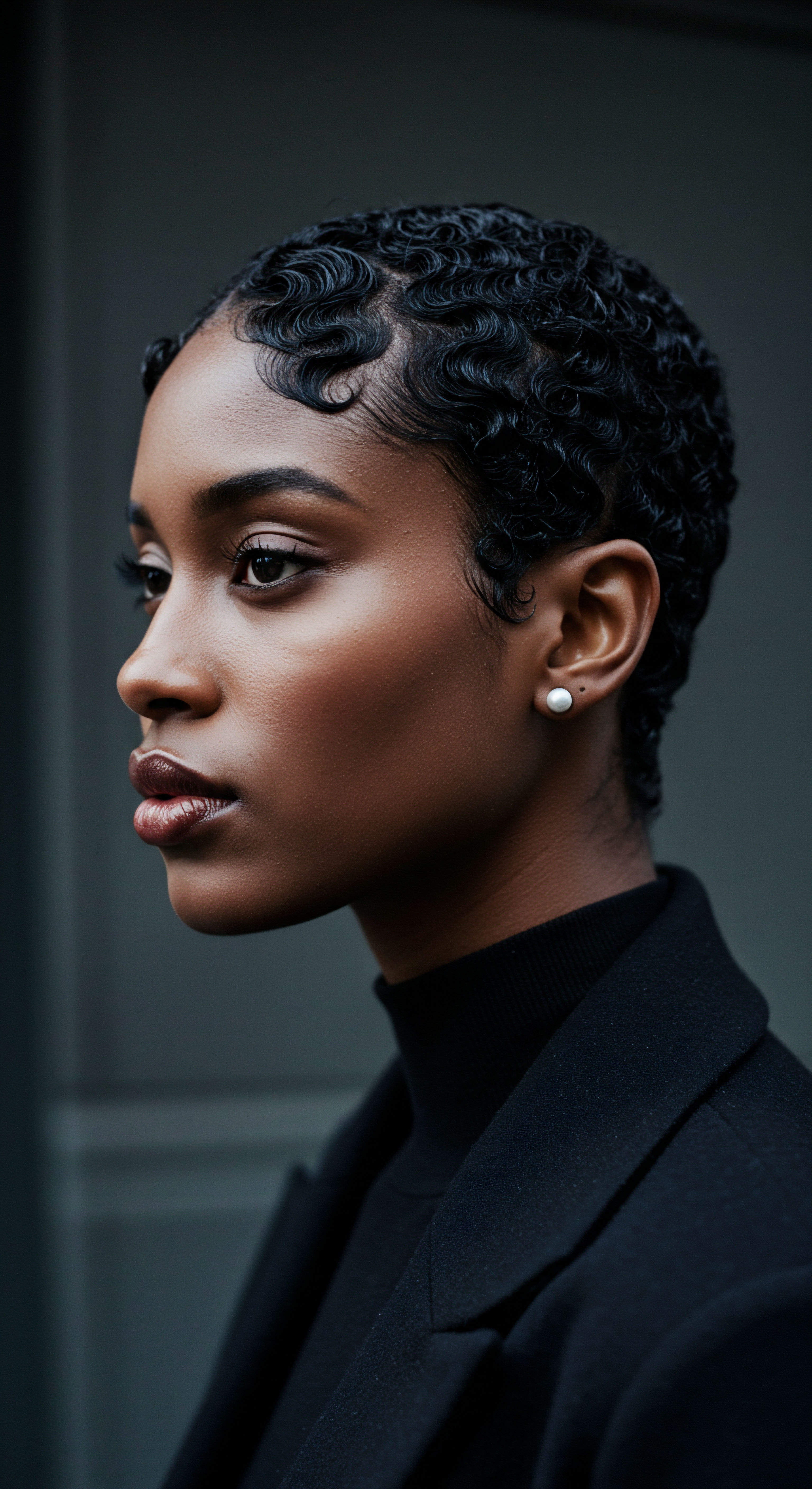
Roots
Consider for a moment the very essence of a single strand of hair, not merely as a decorative adornment, but as a complex marvel of biological engineering. Each strand holds within its delicate structure a silent story of resilience, of environmental interaction, and of ancestral wisdom passed through generations. For those with textured hair, this story often carries particular weight, shaped by unique structural characteristics that dictate how it interacts with the world, especially with something as seemingly simple as a bonnet. Understanding this fundamental interaction begins with appreciating the hair’s outermost guardian ❉ the cuticle.
The hair cuticle, often described as a protective layer, comprises overlapping cells that resemble the shingles on a roof. These tiny, flattened cells are the gatekeepers of moisture, the first line of defense against external aggressors. Their arrangement, whether tightly closed or slightly raised, defines what we term Hair Porosity.
This isn’t a fixed state, but rather a dynamic characteristic influenced by genetics and the cumulative experiences our hair encounters. The way these scales lie determines how readily water and conditioning agents enter or exit the hair shaft, and consequently, how a bonnet can best serve its purpose.

The Hair’s Outer Layer and Its Function
At its very core, the hair fiber consists of three primary layers ❉ the medulla (present in some hair types), the cortex (which holds the hair’s strength and color), and the cuticle. The cuticle, the outermost sheath, consists of six to ten layers of dead, flattened cells. These cells are bonded together by a lipid-rich layer, primarily composed of 18-methyleicosanoic acid (18-MEA), which provides a natural hydrophobic barrier.
This barrier is essential for minimizing water loss and maintaining the hair’s overall integrity. When this protective layer is compromised, whether through mechanical manipulation, chemical treatments, or environmental exposure, the hair’s inherent ability to manage moisture is affected.
Hair porosity, defined by the cuticle’s structure, dictates how strands absorb and retain moisture.

Exploring the Porosity Spectrum
Hair porosity exists on a spectrum, commonly categorized into low, normal, and high, each presenting its own unique set of considerations for hair care.
- Low Porosity Hair ❉ This hair type features tightly packed cuticle layers that lie flat. This compact structure makes it challenging for water and hair products to penetrate the hair shaft. When water is applied, it often beads on the surface or takes a long time to be absorbed. While this tight seal means moisture, once inside, is well-retained, it also means that getting hydration into the hair in the first place requires specific strategies. Products may tend to sit on the surface, leading to buildup if not managed carefully.
- Normal Porosity Hair ❉ Hair with normal porosity has cuticles that are slightly raised, allowing for a balanced exchange of moisture. It absorbs and retains water and products with ease, typically requiring less specialized care. This hair type tends to hold styles well and exhibits a healthy appearance.
- High Porosity Hair ❉ Characterized by raised, chipped, or even missing cuticle layers, high porosity hair readily absorbs moisture. However, this open structure means it loses moisture just as quickly, leading to dryness, frizz, and increased susceptibility to breakage. This condition can be a genetic trait, or it can be induced by external factors such as chemical processing, heat styling, or environmental damage.

Why a Gentle Embrace Matters
The simple act of resting our heads on a pillow, particularly one made of absorbent materials like cotton, can inadvertently strip hair of its natural oils and moisture. This nightly friction can also cause physical damage to the delicate cuticle layer, leading to increased frizz, tangling, and breakage over time. For textured hair, which often has a naturally more disrupted cuticle structure due to its helical shape, this mechanical stress is particularly impactful. A bonnet, in its quiet duty, acts as a soft, protective cocoon, creating a buffer between the hair and the abrasive forces of bedding.
This fundamental protection is where the initial, universal benefit of a bonnet lies, regardless of porosity. It mitigates the physical strain, preserving the hair’s structural integrity and its precious internal moisture.

Ritual
Stepping beyond the foundational understanding of hair’s architecture, we arrive at the realm of daily practice and the quiet, intentional actions that define our hair’s wellbeing. The nighttime ritual, especially for textured hair, transforms from a mere routine into a profound act of self-care, a moment to honor and protect. The bonnet, in this context, is more than an accessory; it is an active participant in a dialogue with your hair’s unique porosity, working in concert with your chosen products to create an optimal environment for health and style preservation. The effectiveness of this nightly pact hinges directly on how we consider porosity when selecting and utilizing this protective headwear.

Choosing the Right Fabric for Your Strands
The material of a bonnet is not a minor detail; it is a decisive factor in how effectively it supports your hair’s porosity. Satin and silk are widely favored for their smooth surfaces, which drastically reduce friction compared to cotton. This smooth surface prevents the snagging and pulling that can lift cuticles and lead to breakage, especially for delicate textured strands.
For those with Low Porosity Hair, the primary challenge involves facilitating moisture entry and preventing product buildup. A satin or silk bonnet creates a less absorbent environment than cotton, meaning any carefully applied leave-in conditioners or stylers are less likely to be absorbed by the fabric and more likely to remain on the hair, providing continuous conditioning. This helps to keep the hair hydrated without oversaturating it, which low porosity hair struggles to dry from. The smooth surface also minimizes the mechanical disruption that could inadvertently raise the tightly closed cuticles.
Conversely, High Porosity Hair, with its open cuticle layers, craves moisture retention. A bonnet crafted from silk or satin helps to create a microclimate that slows down the rate of moisture evaporation from the hair shaft. This gentle enclosure helps to seal in the hydration and emollients applied before bed, allowing the hair to draw upon these resources throughout the night. Without this protective barrier, high porosity hair can quickly lose moisture to absorbent pillowcases, waking up dry and prone to frizz.
The material of a bonnet significantly impacts its efficacy, with smooth fabrics like silk or satin offering superior protection against friction and moisture loss for all porosity types.

Nighttime Practices and Porosity’s Whisper
Beyond fabric choice, the preparatory steps before donning a bonnet are equally telling for porosity-specific care.
For Low Porosity Hair, applying lightweight, water-based leave-in conditioners or hydrators to damp hair before a bonnet can be beneficial. Some individuals find that a light misting of water, followed by a thin layer of product, then immediately covering with a bonnet, helps to create a slightly humid environment that encourages the cuticle to lift just enough to absorb moisture. Avoiding heavy oils or butters that might sit on the surface is often advised, as these can lead to product buildup without truly penetrating.
With High Porosity Hair, the focus shifts to sealing in moisture. Layering a hydrating leave-in with a heavier cream or a sealing oil before covering with a bonnet can be highly effective. The bonnet then acts as the final barrier, preventing the rapid escape of this much-needed hydration. This layering technique helps to replenish the hair’s lipid barrier, which is often compromised in high porosity strands.

Beyond the Fabric A Nightly Pact
The benefits of the bonnet extend beyond the immediate physical protection and moisture management. For many, particularly within Black and mixed-race communities, the act of covering hair at night is deeply rooted in cultural traditions. Head coverings have historically served as symbols of status, modesty, and identity, as well as practical tools for hair preservation.
The modern bonnet carries forward this legacy, providing a practical means to preserve intricate styles, reduce the need for daily manipulation, and thereby lessen overall hair stress. This reduction in daily styling can lead to less breakage over time, contributing to overall hair health and length retention, a silent victory in the ongoing journey of hair care.
The consistent use of a bonnet, tailored to one’s porosity, transforms the nightly rest period into an active phase of hair rejuvenation. It minimizes the environmental stressors of sleeping, allowing the hair to maintain its moisture equilibrium and structural integrity, setting the stage for a more manageable and vibrant appearance each morning.

Relay
To truly appreciate the subtle yet profound influence of hair porosity on bonnet benefits, we must journey into the less visible, often overlooked interactions that shape our hair’s nightly experience. This calls for a deeper contemplation, one that intertwines the precise mechanisms of hair science with the lived realities of textured hair care, drawing upon observations and scholarly insights that extend beyond surface-level discussions. How do the atmospheric conditions created by a bonnet interact with the varying states of the hair cuticle, particularly under conditions of varying porosity? This question guides our exploration into the complex interplay of moisture, friction, and the very structure of the hair itself.

The Microclimate Beneath the Fabric
A bonnet, when worn, creates a localized atmospheric bubble around the hair, a microclimate distinct from the ambient room conditions. This enclosed environment alters the temperature and humidity immediately surrounding the hair strands. Research indicates that the thermal comfort properties within head coverings are influenced by the fabric’s thickness, its moisture retention, and its water absorption properties. For textured hair, which is inherently more prone to dryness due to its coiled structure impeding the natural distribution of sebum, this controlled microclimate is paramount.
Consider High Porosity Hair, where the raised cuticles act like open windows, allowing moisture to escape rapidly. Within the bonnet’s gentle confines, the relative humidity around the hair increases, reducing the vapor pressure difference between the hair and its surroundings. This slows down the rate of water evaporation from the hair shaft, allowing the hair to retain hydration more effectively throughout the night. Conversely, for Low Porosity Hair, which resists moisture penetration, this slight increase in humidity within the bonnet can be a subtle ally.
While not a direct opening of the cuticle, the sustained, gentle warmth and humidity can encourage a very slight softening of the cuticle, potentially making the hair more receptive to moisture applied before bed. This effect, though not as dramatic as direct heat, contributes to better product absorption over hours of wear.
Bonnets create a unique microclimate around hair, influencing moisture exchange differently for varying porosity levels.

Porosity and Product Interaction
The interaction between hair porosity and the efficacy of products under a bonnet is a sophisticated dance. For high porosity hair, the open cuticles mean products are absorbed quickly. The bonnet helps to ensure these products, particularly those designed to seal moisture, have a longer residence time on the hair. This sustained contact allows humectants to draw moisture into the hair and emollients to form a protective film, thereby enhancing moisture retention.
A study on hair lipid structure highlights that lipids, like 18-MEA on the cuticle surface, are vital for water retention and cell cohesion. Their loss increases hydrophilicity and friction. The bonnet acts to preserve these vital surface lipids by reducing friction, thus maintaining the hair’s natural barrier.
For low porosity hair, the challenge remains product penetration. The gentle warmth within a bonnet can slightly raise the hair’s surface temperature, potentially causing a minimal swelling of the cuticle. This minute change, combined with lightweight, water-based products, can aid in their gradual absorption rather than allowing them to simply sit on the hair’s surface. This is a subtle yet significant advantage over exposure to open air, where such products might simply evaporate or transfer to bedding.

The Hidden Cost of Friction
Beyond moisture, the bonnet plays a profound role in mitigating mechanical damage, a factor directly tied to hair porosity. Hair, particularly textured hair, is susceptible to protein loss through friction. Research by Wagner and Joekes (2005) found that human hair subjected to friction while treated with a sodium dodecyl sulfate (SDS) solution experienced Seven Times More Protein Loss than hair exposed to water alone under friction. While this study used a surfactant, it underscores the susceptibility of hair proteins to mechanical abrasion.
High porosity hair, with its already compromised cuticle, is particularly vulnerable to such protein loss. The raised, uneven cuticle scales of high porosity hair create more points of contact and greater surface roughness, leading to increased friction when rubbing against bedding. This elevated friction exacerbates cuticle damage and accelerates protein degradation.
A bonnet, especially one made of smooth satin or silk, acts as a glide surface. It drastically reduces the coefficient of friction between the hair and the pillowcase. By minimizing this abrasive contact, the bonnet directly helps to preserve the hair’s outer cuticle layers and the vital proteins that constitute its structure.
This protective action is not merely about preserving style; it is a fundamental intervention against the cumulative damage that can lead to thinning, breakage, and a loss of hair’s inherent resilience. The long-term implication of this reduction in friction is a healthier, stronger hair shaft, less prone to the mechanical stressors of daily life and nightly rest.

Cultural Echoes in Modern Hair Protection
The protective qualities of head coverings for hair are not a modern discovery; they are deeply rooted in cultural practices spanning centuries. From the intricate headwraps of various African traditions, worn for protection against the elements and as symbols of identity, to the use of silk coverings in other global cultures for hair preservation, the concept of safeguarding hair through covering is a rich historical practice. These traditions recognized, perhaps intuitively, the very principles we now dissect through science ❉ the need to shield hair from environmental aggressors, to maintain its moisture, and to reduce physical stress.
The contemporary bonnet, therefore, is not merely a product of convenience; it is a continuation of a profound cultural legacy of hair care, a testament to enduring wisdom that understood the hair’s delicate nature long before scientific porosity classifications existed. This cultural continuity provides a rich context for the modern benefits we observe, underscoring that hair protection is both a scientific imperative and a cherished tradition.

Reflection
The quiet presence of a bonnet at night holds more than just a promise of preserved curls or minimized frizz. It embodies a nuanced understanding of hair’s very architecture, particularly its porosity, and how this fundamental characteristic dictates its needs. From the tightly bound cuticles of low porosity strands, which seek gentle persuasion for hydration, to the open scales of high porosity hair, which yearn for steadfast moisture retention, the bonnet adapts its silent service.
It transforms the hours of sleep into a period of restorative care, mitigating the subtle abrasions of daily life and reinforcing the hair’s delicate balance. This protective embrace, rooted in both scientific insight and ancestral wisdom, allows textured hair not just to survive, but to truly flourish, honoring its inherent beauty with every passing night.

References
- Wagner, R. de C. C. & Joekes, I. (2005). Hair protein removal by sodium dodecyl sulfate. Colloids and Surfaces B ❉ Biointerfaces, 41(1), 7-14.
- Morel, S. et al. (2023). Advances in Permeation of Solutes into Hair ❉ Influencing Factors and Theoretical Models. Applied Sciences, 13(9), 5577.
- Shetty, V. P. & Jogad, D. R. (2007). Hair Cosmetics ❉ An Overview. Indian Journal of Dermatology, 52(4), 143–149.
- Lee, Y. S. et al. (2025). Thermal Comfort Properties of Wearing Caps from Various Textiles. ResearchGate.
- Hassan, M. et al. (2024). Investigation of the Changes in the Hair Cuticle Due to Chemical Degradation. Uttar Pradesh Journal of Zoology, 45(2), 86-94.
- Gamza-Garcia, M. (2025). Moisture in the Cuticle Sheath ❉ Effects on Hair Mechanical and Cosmetic Properties. ResearchGate.
- Robbins, C. R. (2012). Chemical and Physical Behavior of Human Hair. Springer Science & Business Media.
- Marmol, V. G. et al. (2022). Nanoscale Friction of Biomimetic Hair Surfaces. bioRxiv.
- Bhushan, B. (2010). Biophysics of the Hair and Skin. Springer.
- Keis, K. et al. (2007). The effect of oil films on moisture vapor on human hair. Journal of Cosmetic Science, 58(1), 13-22.